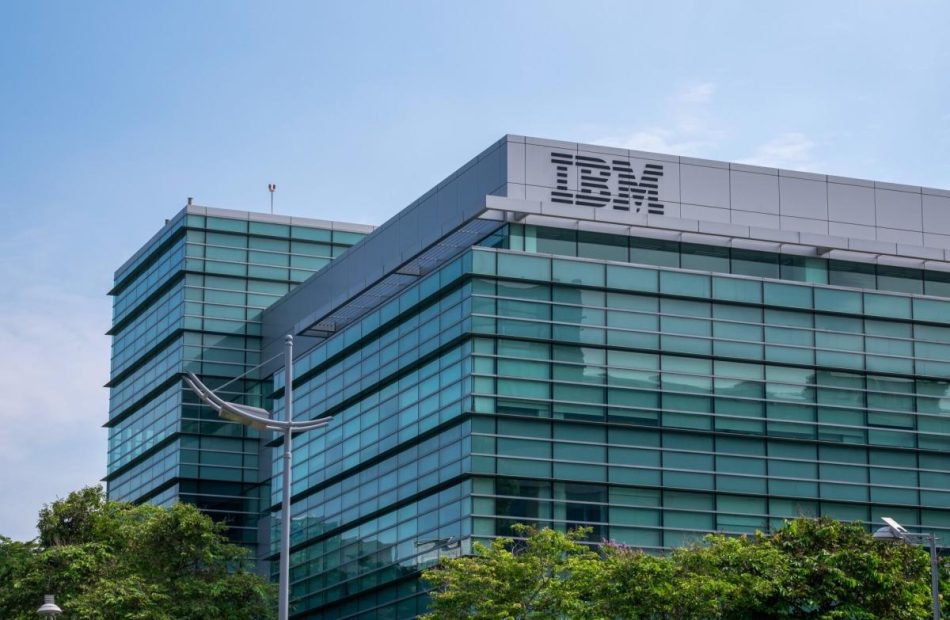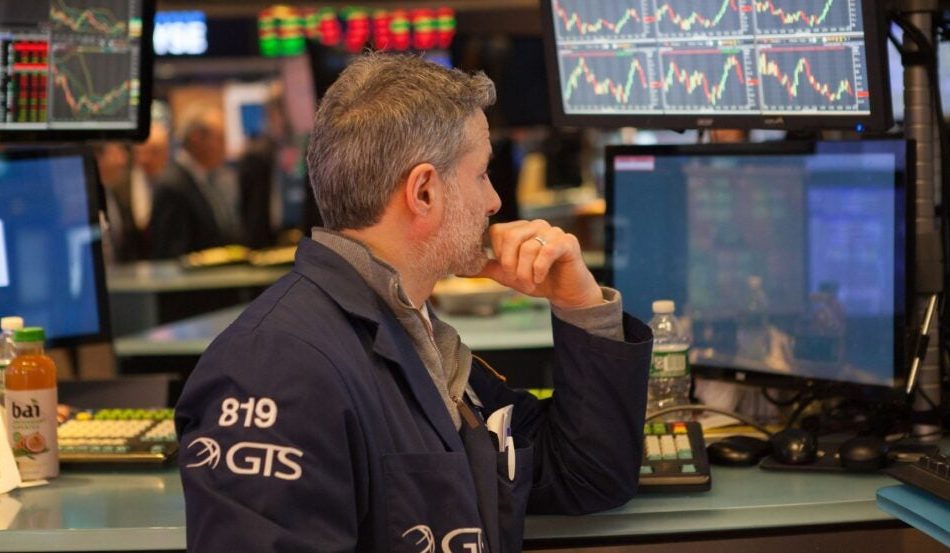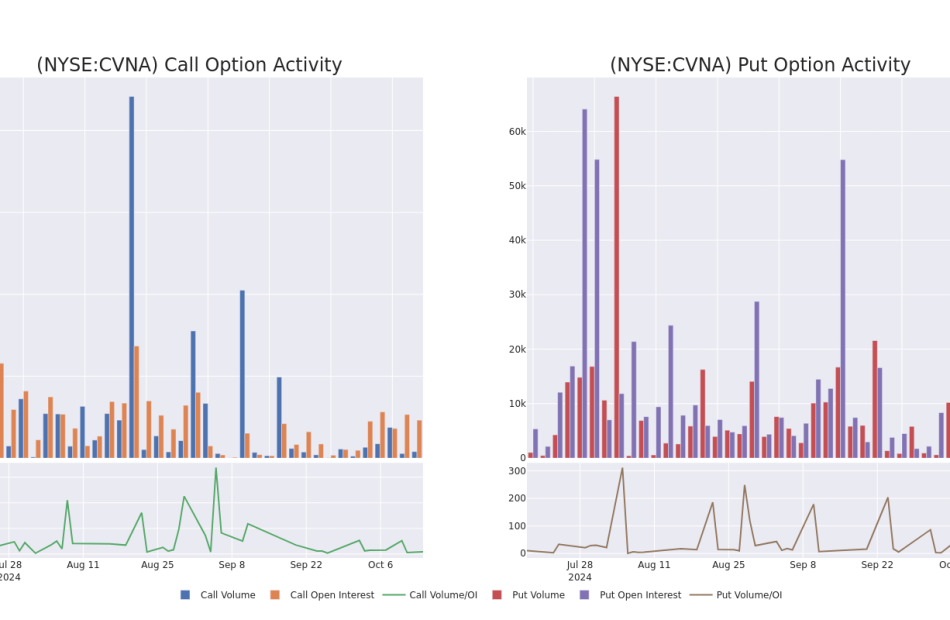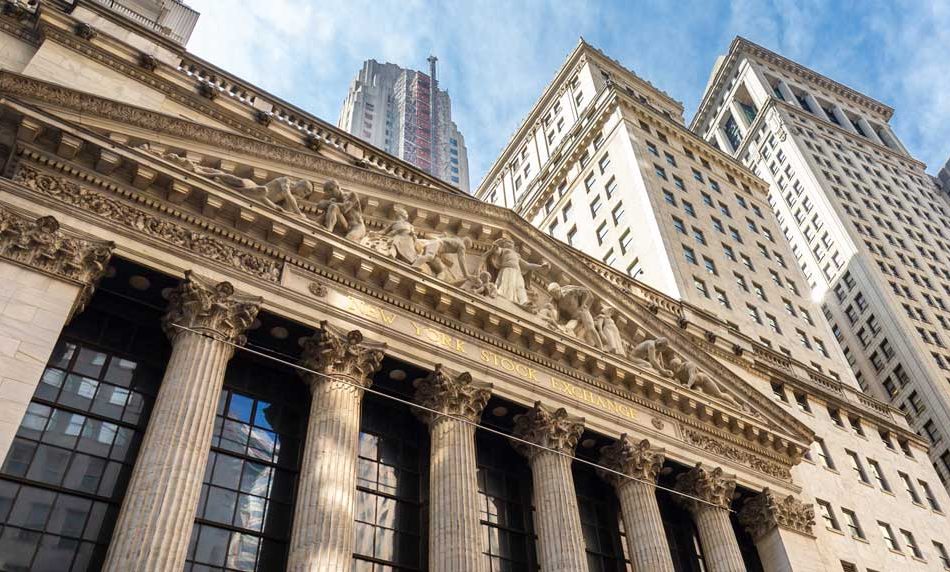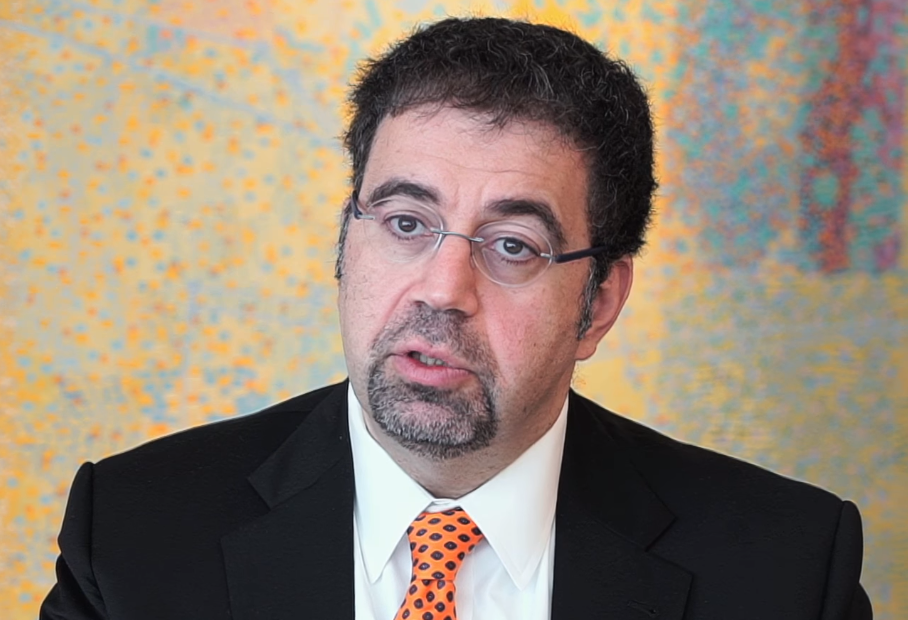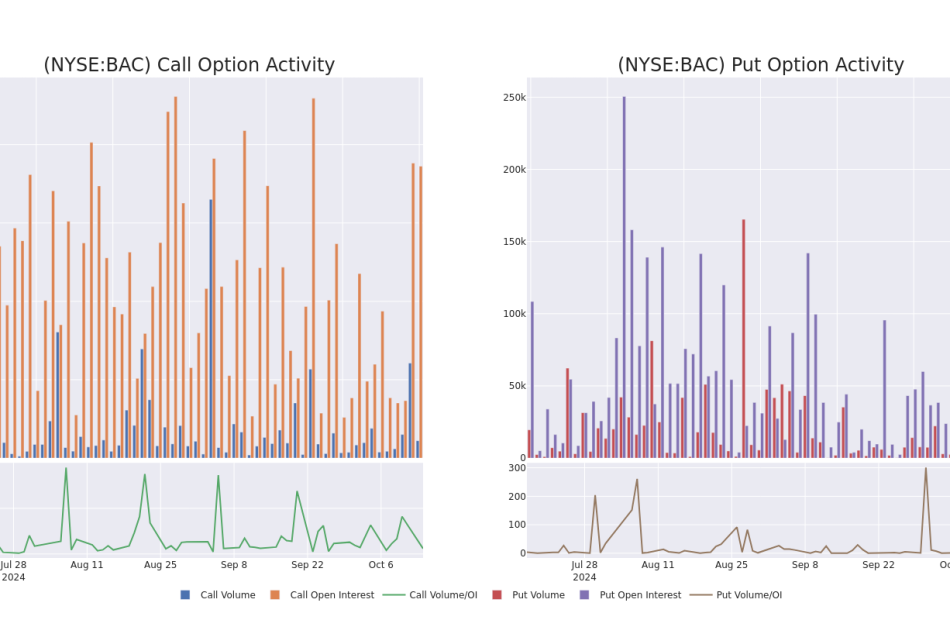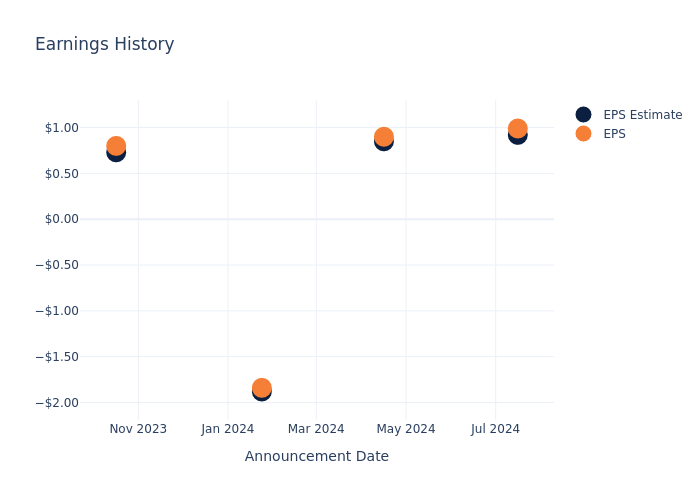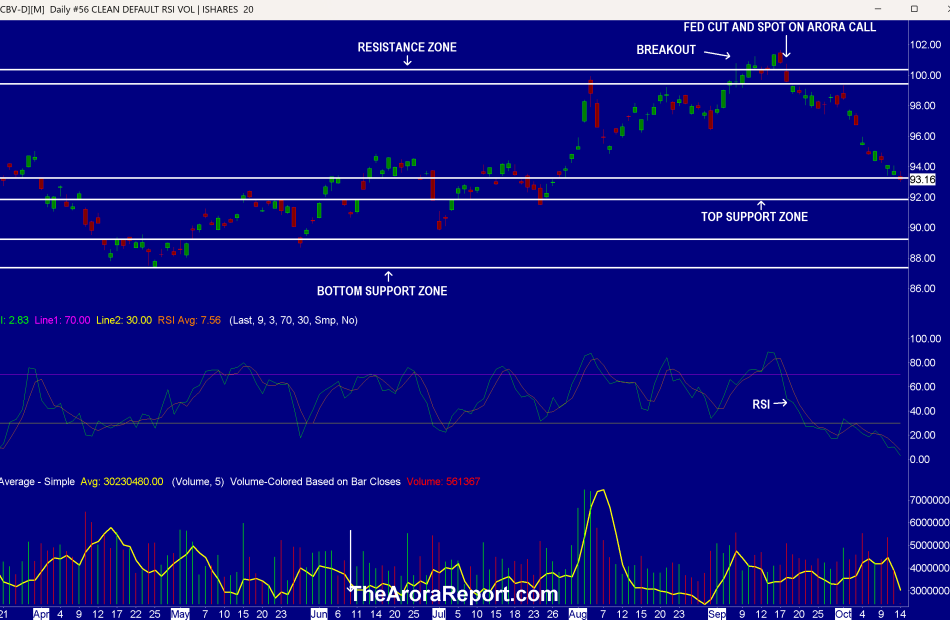IBM Investigates Allegations of Executive Misconduct in China
(Bloomberg) — International Business Machines Corp. is looking into allegations against its China head after a letter circulating online accused the executive of misconduct, including accepting gifts from business partners, the latest upheaval in the US firm’s operations in the Asian country.
Most Read from Bloomberg
A former employee said in a letter to the US company that Chairman Chen Xudong of IBM’s Greater China Group received gift vouchers and cash equivalents from external partners, leaked classified company information to others and violated the company’s expense policies by taking his staff to karaoke bars, several Chinese outlets including the influential business publication Jiemian reported on Monday.
A IBM spokesperson confirmed the existence of the letter and said the company is looking into it.
“IBM takes seriously and thoroughly investigates any alleged behavior that might have violated our business conduct guidelines. We do not discuss individual employee circumstances and remain focused on serving our clients across greater China,” the spokesperson said.
When contacted by a Bloomberg News reporter via WeChat, China’s equivalent of Whatsapp, Chen declined to comment and referred questions to IBM’s communications team.
In August, Bloomberg News reported that IBM was shutting down a hardware research team in China in part due to geopolitical tensions between Washington and Beijing.
–With assistance from Jessica Sui.
Most Read from Bloomberg Businessweek
©2024 Bloomberg L.P.
Nasdaq, S&P 500 Futures Rise Solidly Ahead Of Q3 Earnings Season, Boeing Drags Dow: This Strategist Sees 'A Lot Of Firepower' Supporting Market After Election
U.S. stocks could get off to a mixed start on Monday after the averages posted weekly gains for a fifth straight week. The bond market is closed on account of Columbus Day, which is a federal holiday, but the stock market will trade during usual hours. The majority opinion among strategists hints at a potential pause in stock rally over the next couple of weeks before resuming in the final two months of the year.
That said, earning news flow will pick up momentum in the coming days, potentially cushioning any downside. Cumulative earnings of S&P 500 companies are set to rise for a fifth straight quarter, FactSet said. This, though, would mark a slowdown from the 11.2% growth reported for the second quarter.
On Monday, traders could focus on a couple of Fed speeches and a consumer inflation expectations survey as well as the bond yield even as they look ahead to some key earnings reports over the week.
| Futures | Performance (+/-) |
| Nasdaq 100 | +0.35% |
| S&P 500 | +0.23% |
| Dow | -0.06% |
| R2K | +0.36% |
In premarket trading on Monday, the SPDR S&P 500 ETF Trust SPY added 0.19% to $580.68 and the Invesco QQQ ETF QQQ moved up 0.33% to $495.07, according to Benzinga Pro data.
Cues From Last Week:
Despite the consumer price inflation data throwing investors off guard, the market had enough momentum to keep the rally going in the week ended Oct. 11. A rise in bond yields following some recent strong data and the Hurricane Milton threat also exerted downward pressure on the market, but a benign producer price inflation report and a good start to big bank earnings provided the offsetting impact.
The Dow Jones Industrial Average and the S&P 500 Index ended at fresh intraday and closing highs, while the Nasdaq Composite slowly progressed toward its previous closing high of 18,509.34 hit on July 16.
| Index | Week’s Performance (+/) |
Value |
| Nasdaq Composite | +1.13% | 18,342.94 |
| S&P 500 Index | +1.11% | 5,815.03 |
| Dow Industrials | +1.21% | 42,863.86 |
| Russell 2000 | +0.98% | 2,188.42 |
Insights From Analysts:
Yardeni Research reiterated its call for the S&P 500 to hit 8,000 by 2030 under its “Roaring 2020s” scenario. The index will be supported on its way higher by earnings rather than rising valuation multiples, the firm said. The comments came in the aftermath of the second anniversary of the bull market that began on Oct. 12, 2022.
The period was marked by widespread fears of a recession due to monetary policy tightening, the firm said. “Those fears lingered through October 4 of this year, when a stronger-than-expected employment report once again confirmed that the young bull correctly discounted that inflation would fall while the economy remained resilient,” it said.
Since Oct. 12, 2022, all the major stock market indices are up at least 20%, with the S&P 500 up 62.6%, Yardeni Research said. The S&P 500’s performance is par for the course compared to the previous eight bull markets, it added.
As the momentum remains firmly to the upside, Fund Strat Head of Research Tom Lee said his firm has advised clients to remain cautious but at the same time buy the dips. In an interview with CNBC on Friday, the strategist said investors want to see who ends up president. “We are in a period where the market is sitting on the sidelines,” he said.
At the same time, 2024 has been such a strong year, he said, adding that the last two weeks have proved that macro is taking a step back now, and liquidity and cash on the sidelines are becoming the dominant factor, Lee said. “There is a lot of firepower supporting stocks post election,” he said.
The Fed is dovish, the economy looks healthy, and therefore the three- and six-month outlook is very strong for stocks, he added.
See Also: How To Trade Futures
Upcoming Economic Data
This week’s economic calendar is dominated by Fed speeches, the September retail sales report and a few manufacturing and housing market data. The New York and Philadelphia Feds will release the results of their respective October manufacturing surveys and the Fed is due to announce its September industrial production data. Among the housing data due this week are the National Association of Home Builders housing market index for October and the Commerce Department’s housing starts report for September.
- On Monday, Minneapolis Fed President Neel Kashkari will make public appearances at 9 am EDT and 5 pm EDT.
- The New York Fed is due to release the results of its survey of consumer expectations for September at 11 a.m. EDT. In August, the one- and five-year ahead inflation expectations remained unchanged at 3% and 2.8%, respectively.
- Federal Reserve Governor Christopher Waller is scheduled to speak at 3 p.m.
Stocks In Focus:
- Tesla, Inc. TSLA climbed 1.80% in premarket trading after Friday’s nearly 9% slump.
- Sirius XM Holdings Inc. SIRI climbed nearly 6% after Berkshire Hathaway, Inc. (NYSE; BRK-A) BRK boosted its stake in the company.
- Boeing Co. BA fell over 1.70% after the company announced the elimination of 10% of its workforce.
- Bitcoin’s BTC/USD rally past $64K sent crypto-linked stocks such as MicroStrategy, Inc. MSTR and Coinbase Global, Inc. COIN higher.
Commodities, Bonds And Global Equity Markets:
Crude oil futures tumbled in the early New York session, losing nearly 2.75% as traders turned jittery after the release of weak China data. Gold futures were little changed.
The 10-year Treasury note yield rose marginally to 4.096%.
Most major Asian markets ended higher on Monday, led by the Chinese market. The New Zealand and Hong Kong markets pulled back while the Japanese market was closed for a public holiday.
European stocks showed tentativeness and were mostly lower in early trading.
Read Next:
Image Via Shutterstock
© 2024 Benzinga.com. Benzinga does not provide investment advice. All rights reserved.
EXCLUSIVE: How To Raise Capital In Cannabis – A Guide To Debt And Equity For Avoiding Pitfalls That Sink Most Startups
When your cannabis business needs cash, where do you turn? Should you give up some control for investors or borrow money and risk debt? At the Benzinga Cannabis Capital Conference in Chicago, experts tackled these tough decisions. The panel, “Cannabis Financing 101,” offered practical advice for businesses at every stage.
- Get Benzinga’s exclusive analysis and the top news about the cannabis industry and markets daily in your inbox for free. Subscribe to our newsletter here. You can’t afford to miss out if you’re serious about the business.
Sources Of Funding For Cannabis Startups
Moderated by Marc Claybon, principal-tax at Crowe, the session featured Tayyaba Khan, partner at Cassels; Adam Stettner, CEO of FundCanna; Anthony Coniglio. CEO of NewLake Capital Partners NLCP and Charles Alovisetti, partner at Vicente LLP. They shared essential tips on navigating debt, equity and liquidity in today’s cannabis market.
“For newer companies, friends and family funding is often the only option,” Alovisetti said, pointing out that more established businesses can tap into broader sources such as state grants, social equity programs, or hard money lenders. However, he added, “Not every business is a good candidate for debt. You have to consider cash flow and collateral.”
While startups may struggle to secure traditional financing, larger, more established cannabis operators may have access to sale-leaseback agreements or other forms of asset-backed lending.
Equity Vs. Debt: What Works For Your Business?
Khan detailed the pros and cons of equity versus debt financing. Equity financing offers flexibility, as businesses do not have to repay funds immediately, but it comes at the cost of ownership. “You’re giving up a piece of your company, and investors will likely want a say in decision-making,” she explained.
Debt, on the other hand, allows companies to retain ownership but comes with repayment obligations. “Debt is cheaper capital than equity,” Khan said but warned that companies need to carefully manage their cash flow to meet repayment schedules. Interest payments may offer tax deductions, but missing debt payments can lead to default or loss of assets.
Read Also: Budtenders Letting You Down? Meet The Weed Bot That Actually Knows What You Want
Debt Can’t Wait: Tackling The AR Dilemma
A recurring challenge in the cannabis industry is the management of accounts receivable (AR). Stettner highlighted this issue. “The one thing that we’re universally dealing with is delinquent AR. It doesn’t matter where you are in the supply chain—it’s an issue.”
The mismatch between payment terms and revenue cycles exacerbates the problem. “It’s very hard as a purchaser to make payment on goods when you don’t have revenue from the goods you’ve purchased,” Stettner said. He urged businesses to ensure that their debt repayment schedules align with revenue cycles. “Debt is not a four-letter word,” he joked, noting that even companies like Apple and Google use leverage for growth. “It’s about doing it right.”
Real Estate: Lease, Own Or Sale-Leaseback?
Real estate is a critical issue for cannabis businesses and the complexities are magnified by the disconnect between federal and state laws. Coniglio pointed out that most landlords with federally-backed mortgages are prohibited from leasing to cannabis companies, creating a significant barrier. “This forces many operators to buy properties outright, tying up capital that could be used elsewhere,” he said.
Cannabis businesses have several options when dealing with real estate challenges.
Some choose to buy and then finance their property through banks, though this often comes at a “haircut to the non-cannabis value,” as Coniglio described it. Others turn to specialized lending or sale-leaseback agreements.
In a sale-leaseback, companies sell their property to a real estate investment trust (REIT) or another buyer, then lease it back under a long-term agreement. This allows them to unlock the capital tied up in real estate while continuing operations.
Coniglio explained that each option has its pros and cons, and businesses need to assess their long-term strategies. “Real estate is a core part of any cannabis business, and companies need to explore all their options carefully,” he concluded.
Read Also: It’s Your Constitutional Right: How You Can Break The Senate’s Block On Cannabis Legalization
Cash Flow: The Lifeblood of Cannabis Finance
Throughout the discussion, the panelists repeatedly stressed the importance of cash flow. “Cash flow is the most critical part of this whole conversation,” Coniglio said. Whether pursuing debt or equity financing, investors will always examine a company’s cash flow to determine its ability to repay loans or generate returns.
Stettner agreed, warning that businesses must focus on realistic cash flow projections. “Nobody is going to lend you money if they don’t see how you’ll pay it back,” he said.
Read Next: EXCLUSIVE: Inside The Amazon Of Weed, Helping 400 Cannabis Brands Save And Grow In Regulatory Maze
© 2024 Benzinga.com. Benzinga does not provide investment advice. All rights reserved.
Carvana Unusual Options Activity
Investors with a lot of money to spend have taken a bearish stance on Carvana CVNA.
And retail traders should know.
We noticed this today when the trades showed up on publicly available options history that we track here at Benzinga.
Whether these are institutions or just wealthy individuals, we don’t know. But when something this big happens with CVNA, it often means somebody knows something is about to happen.
So how do we know what these investors just did?
Today, Benzinga‘s options scanner spotted 34 uncommon options trades for Carvana.
This isn’t normal.
The overall sentiment of these big-money traders is split between 35% bullish and 55%, bearish.
Out of all of the special options we uncovered, 15 are puts, for a total amount of $1,078,765, and 19 are calls, for a total amount of $3,704,445.
What’s The Price Target?
After evaluating the trading volumes and Open Interest, it’s evident that the major market movers are focusing on a price band between $50.0 and $270.0 for Carvana, spanning the last three months.
Volume & Open Interest Trends
Assessing the volume and open interest is a strategic step in options trading. These metrics shed light on the liquidity and investor interest in Carvana’s options at specified strike prices. The forthcoming data visualizes the fluctuation in volume and open interest for both calls and puts, linked to Carvana’s substantial trades, within a strike price spectrum from $50.0 to $270.0 over the preceding 30 days.
Carvana 30-Day Option Volume & Interest Snapshot
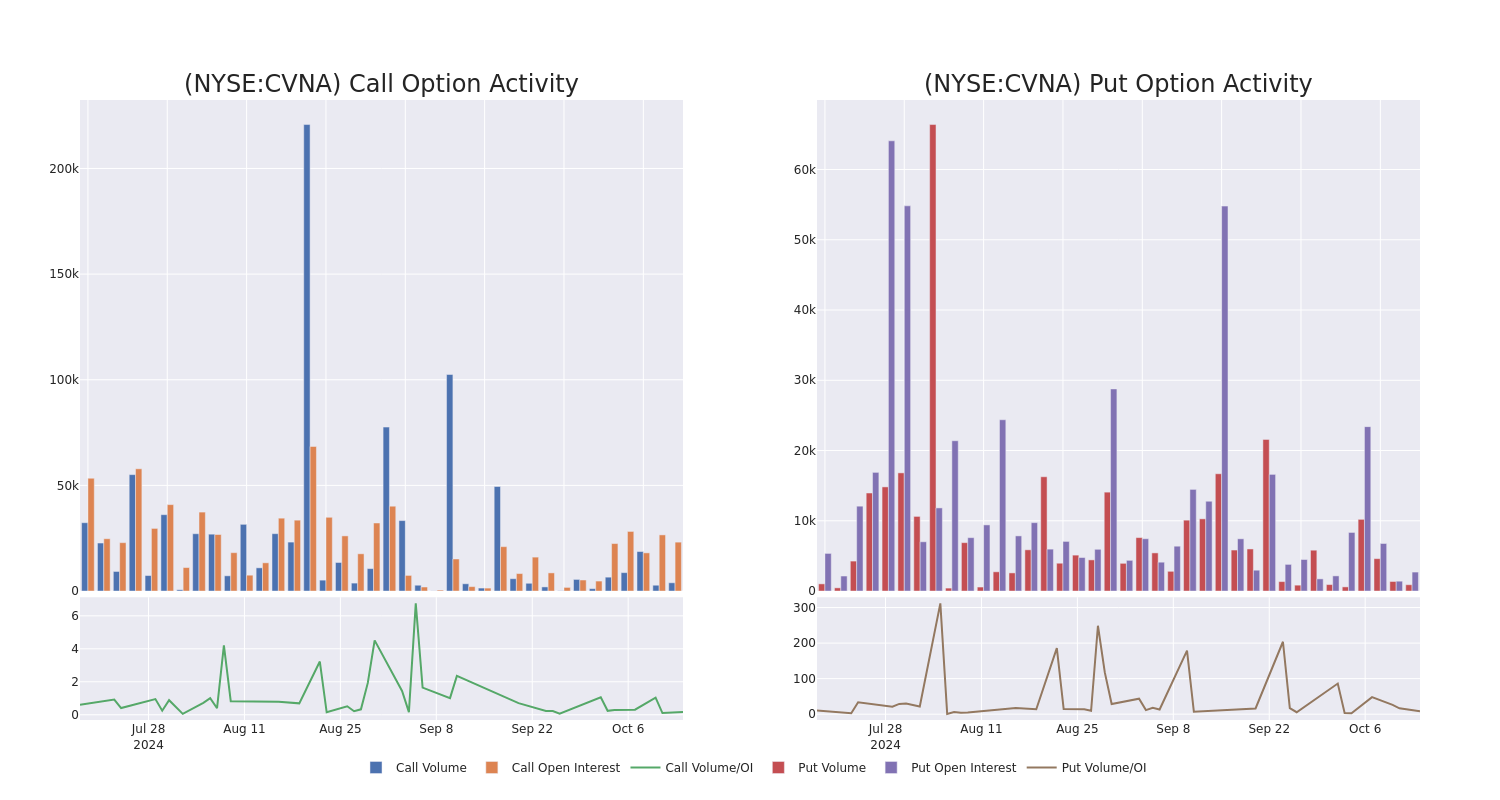
Noteworthy Options Activity:
| Symbol | PUT/CALL | Trade Type | Sentiment | Exp. Date | Ask | Bid | Price | Strike Price | Total Trade Price | Open Interest | Volume |
|---|---|---|---|---|---|---|---|---|---|---|---|
| CVNA | CALL | TRADE | BULLISH | 01/17/25 | $47.85 | $47.35 | $47.85 | $155.00 | $952.2K | 11.6K | 400 |
| CVNA | CALL | SWEEP | BEARISH | 01/17/25 | $48.05 | $47.05 | $47.05 | $155.00 | $941.0K | 11.6K | 800 |
| CVNA | CALL | TRADE | BULLISH | 01/17/25 | $44.25 | $43.75 | $44.25 | $160.00 | $854.0K | 5.3K | 400 |
| CVNA | PUT | SWEEP | BEARISH | 11/15/24 | $11.55 | $11.35 | $11.55 | $180.00 | $205.5K | 329 | 199 |
| CVNA | CALL | SWEEP | BULLISH | 01/17/25 | $46.6 | $46.05 | $46.6 | $155.00 | $163.1K | 11.6K | 1.2K |
About Carvana
Carvana Co is an e-commerce platform for buying and selling used cars. The company derives revenue from used vehicle sales, wholesale vehicle sales and other sales and revenues. The other sales and revenues include sales of loans originated and sold in securitization transactions or to financing partners, commissions received on VSCs and sales of GAP waiver coverage. The foundation of the business is retail vehicle unit sales. This drives the majority of the revenue and allows the company to capture additional revenue streams associated with financing, VSCs, auto insurance and GAP waiver coverage, as well as trade-in vehicles.
In light of the recent options history for Carvana, it’s now appropriate to focus on the company itself. We aim to explore its current performance.
Current Position of Carvana
- With a volume of 802,040, the price of CVNA is up 0.18% at $192.59.
- RSI indicators hint that the underlying stock may be overbought.
- Next earnings are expected to be released in 16 days.
Professional Analyst Ratings for Carvana
Over the past month, 5 industry analysts have shared their insights on this stock, proposing an average target price of $191.4.
Turn $1000 into $1270 in just 20 days?
20-year pro options trader reveals his one-line chart technique that shows when to buy and sell. Copy his trades, which have had averaged a 27% profit every 20 days. Click here for access.
* An analyst from B of A Securities downgraded its action to Buy with a price target of $185.
* Consistent in their evaluation, an analyst from JP Morgan keeps a Overweight rating on Carvana with a target price of $230.
* An analyst from Wedbush has decided to maintain their Neutral rating on Carvana, which currently sits at a price target of $175.
* An analyst from B of A Securities persists with their Buy rating on Carvana, maintaining a target price of $210.
* Maintaining their stance, an analyst from Evercore ISI Group continues to hold a In-Line rating for Carvana, targeting a price of $157.
Options trading presents higher risks and potential rewards. Astute traders manage these risks by continually educating themselves, adapting their strategies, monitoring multiple indicators, and keeping a close eye on market movements. Stay informed about the latest Carvana options trades with real-time alerts from Benzinga Pro.
Market News and Data brought to you by Benzinga APIs
© 2024 Benzinga.com. Benzinga does not provide investment advice. All rights reserved.
Boeing’s Endless Doom Loop Gives No Respite to CEO Ortberg
(Bloomberg) — As Boeing Co. lurches from one crisis to the next, there’s been one constant for the embattled planemaker: Its predicament appears to be only getting worse.
Most Read from Bloomberg
From a freak accident that blew a door-size hole into the fuselage of an airborne 737 Max to revelations of sloppy workmanship and now a crippling strike entering its second month — the icon of US manufacturing has been beset by trouble since the first days of January. Cash is dwindling, plane production is anemic and the stock is heading for its worst annual performance since the financial crisis in 2008.
Now the planemaker is making another dramatic move by cutting 10% of its workforce, equivalent to about 17,000 people. But it’s a maneuver fraught with risk, given that Boeing is in the middle of testy labor negotiations and unions show no sign of giving in. Also left unanswered were details on where the cuts will occur, what they might cost in terms of severance — and if indeed the step is enough to stem the financial bleeding.
“It’s all getting a bit hand to mouth,” said Nick Cunningham, an analyst at Agency Partners LLP in London. “It is not a coherent plan as such, it is just another quarter of large charges, all of a kind the previous management would have had to make anyway, as they reflect existing and developing problems and are not part of a restructuring as such.”
Boeing’s shares fell 2.5% as of 9:33 a.m. in New York on Monday, the first trading session since the cuts were announced. The stock had declined 42% this year through Friday’s close, the second-worst performer in the Dow Jones Industrial Average behind Intel Corp.
In his announcement of the job cuts, new Chief Executive Officer Kelly Ortberg tucked in a hint that yet more dramatic action might be needed to get the company back on course.
“We need to be clear-eyed about the work we face and realistic about the time it will take to achieve key milestones on the path to recovery,” the Boeing chief wrote in the Oct. 11 memo to workers. “We also need to focus our resources on performing and innovating in the areas that are core to who we are.”
The comments suggest that Boeing under Ortberg may double down on the field for which it is best known: Commercial aviation. The unceremonious departure of Ted Colbert as head of the defense and space business put those subsidiary’s shortcomings into sharp relief — made more glaring still on Friday when Boeing said the unit would have about $2 billion in charges in the third quarter.
The episodes bedeviling Boeing have exposed quality lapses at Boeing and its supply chain, alongside a corrosive culture a quarter-century in the making, where pressure over costs and schedule permeated decision-making. Earlier this year, customers finally revolted and the board shook up leadership, hiring Ortberg in August out of retirement to fix the beleaguered manufacturer.
There’s broad agreement by observers that the company will need more time to regain its footing — the Federal Aviation Administration’s top official has said it’s a matter of years, not months, before Boeing is stabilized. When Ortberg, 64, hosts his first earnings call as CEO on Oct. 23, investors will want more detail on how he intends to comprehensively lead one of the toughest revivals in corporate America, rather than just putting out fires.
Rating agencies have put Boeing on notice with a warning that it may slip below investment grade, a move that would make the planemaker the biggest so-called fallen angel in corporate US history. The company has only a small buffer on top of the $10 billion of cash and short-term securities that it needs to avoid slipping to junk status. The toll from the strike increases the urgency to tap markets sooner rather than later for fresh financing.
Continuous Loop
“For every problem that’s come to a head, then severed, more problems sprout up,” Ron Epstein, an analyst with Bank of America, wrote in a note to clients. “The issues all feed into each other, creating a continuous doom loop while compounding the negative impacts.”
All told, Boeing will record $5 billion in combined charges for its two largest businesses when it formally reports third-quarter earnings, the company said Friday evening in a surprise announcement. Besides the defense and space charges, Boeing will book additional costs for pushing back its 777X model once more, leaving its largest widebody aircraft with a delay of about six years.
Much is unclear about Boeing’s turnaround efforts. The ramp-up in production that was supposed to help cash flow has been undercut by the recent strike, and the defense and space business continues to hemorrhage money.
The company still needs to buy back Spirit AeroSystems Holdings Inc., which it had hived off in an ill-fated move almost two decades ago, only to see manufacturing quality at its key supplier suffer as a result.
Longer-term, Boeing may need to make some tough calls on unprofitable areas like its space endeavors. The division made global headlines a few weeks ago when its Starliner capsule returned to earth without humans on board. It was an ignominious end to its first crewed mission to orbit after NASA decided not to risk putting two astronauts back into the glitch-prone spacecraft.
Ortberg hasn’t done any media interviews since taking over, although he’s reached out to customers, regulators, Pentagon officials and toured Boeing factories. An engineer by training, Ortberg spent most of his career at what is now known as Collins Aerospace, a well-regarded avionics equipment manufacturer that’s a key supplier to Boeing.
As CEO, Ortberg has appealed to a sense of camaraderie and shared destiny with the workforce. He made a point about relocating to Seattle from West Palm Beach, Florida, in a departure from his predecessor, who largely ran the company from the other side of the continent.
Cash Drain
When the strike started in mid September, the CEO urged workers to embrace the future and not hold grudges, a nod to a 2014 contract that cost them their pensions. Senior management took solidarity pay reductions when Ortberg announced furloughs to preserve cash, and the latest job cuts will also include executives and management, he said.
But with so-called touch labor accounting for less than 5% for the total cost of a commercial aircraft program, some observers wonder why Boeing isn’t moving with more urgency to end the work stoppage that’s adding to its financial distress.
“It’s not a needle mover in terms of Boeing profitability,” said Ken Herbert, analyst with RBC Capital Markets. “What are we waiting for here? Every day that goes by, it’s more disruptive and more of a cash drain.”
With the job cuts, Ortberg wants to instill a sense of urgency and shared sacrifice, said George Ferguson, an analyst with Bloomberg Intelligence. But the move threatens further antagonizing the very workers Boeing needs to restart jetliner production, at a time when skilled mechanics are in high demand.
Even before Friday’s announcement, the war of words had intensified. Both Boeing and the union filed formal complaints accusing the other of breaching the protocol for labor negotiations.
“He can’t win without the union,” Ferguson said of Ortberg. “He needs their heart and soul when they come back to the floor. If there was a honeymoon for the CEO, it seems to be over.”
–With assistance from Siddharth Philip and Danny Lee.
(Updates with opening share movement in the fifth paragraph.)
Most Read from Bloomberg Businessweek
©2024 Bloomberg L.P.
Stock Market Holidays 2024: Is Wall Street Closed For Columbus Day? Yes And No.
↑
X
Is Wall Street Closed On New Year’s Day? These Are The 2024 Stock Market Holidays
The Nasdaq, S&P 500 and Dow industrial indexes have rallied near fresh record highs to start October, following a September rebound. A string of good economic news — including the strong September jobs report and the Federal Reserve’s move toward a rate-cut cycle — have put the market in a healthy position as Q3 results kick off. However, the bond markets will take a quick break for the Columbus Day/Indigenous Peoples’ Day holiday.
The bond markets close on Monday, Oct. 14, then reopen Tuesday to trade normally for the remainder of the week. The New York Stock Exchange and Nasdaq will remain open.
Here is a look at other upcoming stock market holidays.
What Are Stock Market Holidays?
A so-called market holiday is any nonweekend day when the New York Stock Exchange, Nasdaq, or bond markets close for the day. Usually, that holiday is something like Thanksgiving or Christmas.
On some holidays, or days close to them, the stock markets remain open, while the bond markets stay closed or close early. Sometimes, the markets close for national days of mourning, as the New York Stock Exchange and Nasdaq did to honor the late president George H.W. Bush in 2018.
If a given holiday happens to take place on Saturday, the Friday before it typically becomes a stock market holiday. Similarly, markets typically close on the following Monday if the holiday lands on a Sunday.
Regular hours for the New York Stock Exchange and the Nasdaq go from 9:30 a.m. to 4 p.m. ET from Monday to Friday. The markets are closed over the weekends.
Full Stock Market Holidays 2024
The following are the stock market holidays in 2024 when the NYSE, Nasdaq and bond markets are all fully closed:
- Monday, Jan. 15 — Martin Luther King Jr. Day
- Monday, Feb. 19 — Presidents’ Day
- Friday, March 29 — Good Friday
- Monday, May 27 — Memorial Day
- Wednesday, June 19 — Juneteenth
- Thursday, July 4 — Independence Day
- Monday, Sept. 2 — Labor Day
- Thursday, Nov. 28 — Thanksgiving Day
- Wednesday, Dec. 25 — Christmas Day
Below, we also include partial market closures for 2024.
Is The Stock Market Open On New Year’s Day 2024?
The stock market will close on Monday, Jan. 1 to observe the New Year’s Day holiday.
Is The Stock Market Open On Presidents’ Day/Washington’s Birthday?
Stock and bond markets will be closed on Monday Feb. 19, and reopen for normal trade on Tuesday, Feb. 20.
Is The Stock Market Open The Thursday Before Good Friday?
The stock market holds regular hours on March 28, the date on which Maundy Thursday falls in 2024. Bond markets close early, at 2 p.m.
Is The Stock Market Open The Friday Before Memorial Day?
The stock market is open on the Friday before Memorial Day. But the bond markets close early, at 2 p.m.
Is The Stock Market Open On July 3?
U.S. stock markets will be open on July 3, but will close early, at 1 p.m. ET. Bond markets will shut down at 2 p.m.
Is The Stock Market Open On Columbus Day/Indigenous Peoples’ Day?
Yes. The NYSE and the Nasdaq are open on Columbus Day/Indigenous Peoples’ Day, which in 2024 lands on Monday, Oct. 14.
As for the bond markets? Closed that day.
Is The Stock Market Open On Veterans Day?
The bond markets will close for Veterans Day on Nov. 11, 2024.
… And Black Friday?
The stock markets close early, at 1 p.m. ET, on Black Friday, the day after Thanksgiving. Black Friday in 2024 lands on Nov. 29. The bond markets close early, at 2 p.m.
… Christmas Eve?
The stock market will close early at 1 p.m. ET on Tuesday, Dec. 24 for Christmas Eve. The bond markets will close early at 2 p.m. ET.
Is The Stock Market Open New Year’s Eve?
The bond markets will close early at 2 p.m. ET on Tuesday, Dec. 31 for New Year’s Eve. The stock market will hold regular hours for the last day of 2024, before taking New Year’s Day off.
YOU MAY ALSO LIKE:
Best Growth Stocks To Buy And Watch: See Updates To IBD Stock Lists
Looking For The Next Big Stock Market Winners? Start With These 3 Steps
Learn How To Time The Market With IBD’s ETF Market Strategy
Join IBD Live And Learn Top Chart Reading And Trading Techniques From Pros
Futures Mixed After Bulls Run As Markets Mull China Stimulus
US Economists Daron Acemoglu, Simon Johnson And James Robinson Win Nobel Prize For Groundbreaking Research On Global Wealth Inequality
Three U.S.-based economists have been awarded the prestigious Nobel Prize in Economic Sciences for their significant contributions to understanding global wealth inequality.
As per the official press release, U.S.-based economists Daron Acemoglu, Simon Johnson, and James Robinson were awarded the Nobel Prize in Economic Sciences on Monday. The trio was recognized for their groundbreaking research on wealth inequality between nations.
The Nobel Committee highlighted their work on how societies with inadequate legal frameworks and exploitative institutions fail to achieve economic growth. Acemoglu and Johnson are professors at the Massachusetts Institute of Technology, while Robinson is the director of the University of Chicago’s Pearson Institute.
Their influential 2012 book, “Why Nations Fail: The Origins of Power, Prosperity, and Poverty,” delves into the roots of inequality and the factors that enable some countries to thrive. Jakob Svensson from Stockholm University praised their empirical and theoretical contributions to understanding global inequality.
The winners will share the prize money of 11 million Swedish kronor ($1.058 million), awarded by the Swedish central bank. This award, formally known as the “Sveriges Riksbank Prize in Economic Sciences in Memory of Alfred Nobel,” was first introduced in 1968.
Read Next:
Image via Wikimedia Commons
This story was generated using Benzinga Neuro and edited by Pooja Rajkumari
Market News and Data brought to you by Benzinga APIs
© 2024 Benzinga.com. Benzinga does not provide investment advice. All rights reserved.
Market Whales and Their Recent Bets on BAC Options
Financial giants have made a conspicuous bullish move on Bank of America. Our analysis of options history for Bank of America BAC revealed 18 unusual trades.
Delving into the details, we found 50% of traders were bullish, while 44% showed bearish tendencies. Out of all the trades we spotted, 5 were puts, with a value of $381,663, and 13 were calls, valued at $515,136.
Expected Price Movements
Based on the trading activity, it appears that the significant investors are aiming for a price territory stretching from $28.0 to $43.5 for Bank of America over the recent three months.
Analyzing Volume & Open Interest
Looking at the volume and open interest is a powerful move while trading options. This data can help you track the liquidity and interest for Bank of America’s options for a given strike price. Below, we can observe the evolution of the volume and open interest of calls and puts, respectively, for all of Bank of America’s whale trades within a strike price range from $28.0 to $43.5 in the last 30 days.
Bank of America Option Volume And Open Interest Over Last 30 Days
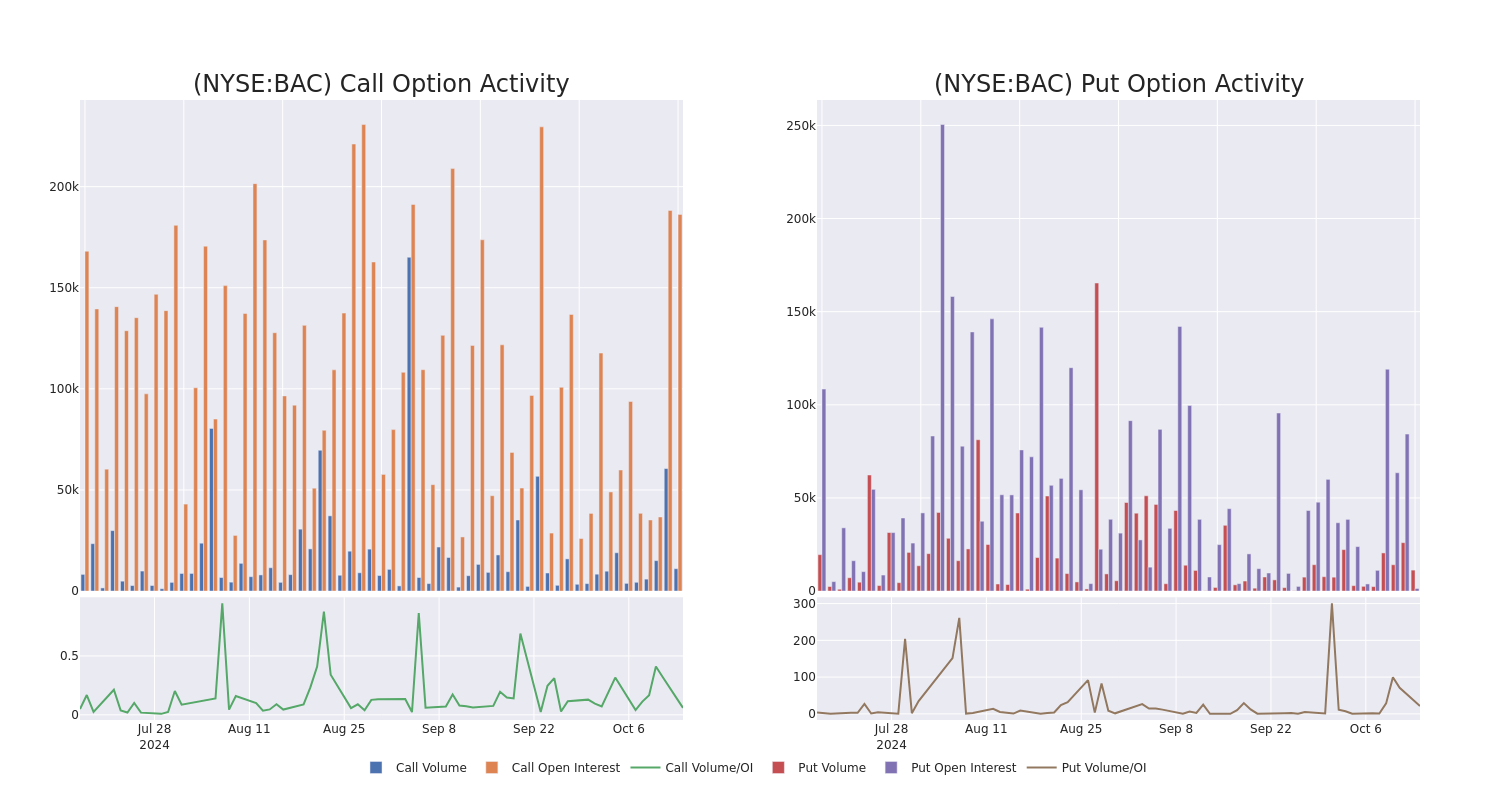
Noteworthy Options Activity:
| Symbol | PUT/CALL | Trade Type | Sentiment | Exp. Date | Ask | Bid | Price | Strike Price | Total Trade Price | Open Interest | Volume |
|---|---|---|---|---|---|---|---|---|---|---|---|
| BAC | PUT | SWEEP | BEARISH | 10/18/24 | $1.76 | $1.55 | $1.73 | $43.50 | $173.0K | 87 | 1.0K |
| BAC | PUT | SWEEP | BEARISH | 10/18/24 | $0.55 | $0.54 | $0.55 | $41.50 | $110.0K | 1.1K | 2.5K |
| BAC | CALL | TRADE | BULLISH | 01/17/25 | $14.3 | $14.15 | $14.25 | $28.00 | $85.5K | 18.3K | 60 |
| BAC | CALL | TRADE | BEARISH | 01/16/26 | $9.55 | $9.45 | $9.45 | $35.00 | $56.7K | 8.9K | 60 |
| BAC | CALL | TRADE | BULLISH | 10/18/24 | $0.43 | $0.42 | $0.43 | $43.00 | $43.0K | 34.8K | 1.3K |
About Bank of America
Bank of America is one of the largest financial institutions in the United States, with more than $3.0 trillion in assets. It is organized into four major segments: consumer banking, global wealth and investment management, global banking, and global markets. Bank of America’s consumer-facing lines of business include its network of branches and deposit-gathering operations, retail lending products, credit and debit cards, and small-business services. The company’s Merrill Lynch operations provide brokerage and wealth-management services, as does its private bank. Wholesale lines of business include investment banking, corporate and commercial real estate lending, and capital markets operations. Bank of America has operations in several countries but is primarily US-focused.
Following our analysis of the options activities associated with Bank of America, we pivot to a closer look at the company’s own performance.
Current Position of Bank of America
- Currently trading with a volume of 8,794,046, the BAC’s price is up by 0.23%, now at $42.05.
- RSI readings suggest the stock is currently may be approaching overbought.
- Anticipated earnings release is in 1 days.
What Analysts Are Saying About Bank of America
A total of 3 professional analysts have given their take on this stock in the last 30 days, setting an average price target of $47.333333333333336.
Turn $1000 into $1270 in just 20 days?
20-year pro options trader reveals his one-line chart technique that shows when to buy and sell. Copy his trades, which have had averaged a 27% profit every 20 days. Click here for access.
* An analyst from RBC Capital downgraded its action to Outperform with a price target of $46.
* An analyst from Morgan Stanley has decided to maintain their Overweight rating on Bank of America, which currently sits at a price target of $47.
* An analyst from Oppenheimer persists with their Outperform rating on Bank of America, maintaining a target price of $49.
Trading options involves greater risks but also offers the potential for higher profits. Savvy traders mitigate these risks through ongoing education, strategic trade adjustments, utilizing various indicators, and staying attuned to market dynamics. Keep up with the latest options trades for Bank of America with Benzinga Pro for real-time alerts.
Market News and Data brought to you by Benzinga APIs
© 2024 Benzinga.com. Benzinga does not provide investment advice. All rights reserved.
Equity Bancshares's Earnings: A Preview
Equity Bancshares EQBK is gearing up to announce its quarterly earnings on Tuesday, 2024-10-15. Here’s a quick overview of what investors should know before the release.
Analysts are estimating that Equity Bancshares will report an earnings per share (EPS) of $1.00.
Anticipation surrounds Equity Bancshares’s announcement, with investors hoping to hear about both surpassing estimates and receiving positive guidance for the next quarter.
New investors should understand that while earnings performance is important, market reactions are often driven by guidance.
Historical Earnings Performance
During the last quarter, the company reported an EPS beat by $0.07, leading to a 0.64% increase in the share price on the subsequent day.
Here’s a look at Equity Bancshares’s past performance and the resulting price change:
| Quarter | Q2 2024 | Q1 2024 | Q4 2023 | Q3 2023 |
|---|---|---|---|---|
| EPS Estimate | 0.92 | 0.85 | -1.88 | 0.73 |
| EPS Actual | 0.99 | 0.90 | -1.84 | 0.80 |
| Price Change % | 1.0% | -0.0% | -2.0% | -3.0% |
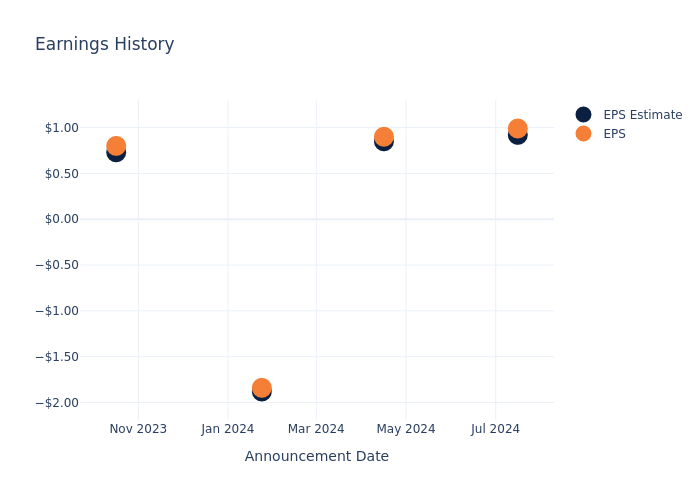
Equity Bancshares Share Price Analysis
Shares of Equity Bancshares were trading at $41.43 as of October 11. Over the last 52-week period, shares are up 69.67%. Given that these returns are generally positive, long-term shareholders are likely bullish going into this earnings release.
To track all earnings releases for Equity Bancshares visit their earnings calendar on our site.
This article was generated by Benzinga’s automated content engine and reviewed by an editor.
Market News and Data brought to you by Benzinga APIs
© 2024 Benzinga.com. Benzinga does not provide investment advice. All rights reserved.
Bonds Defy Expectations, Earnings Season Will Be A Tell For AI
To gain an edge, this is what you need to know today.
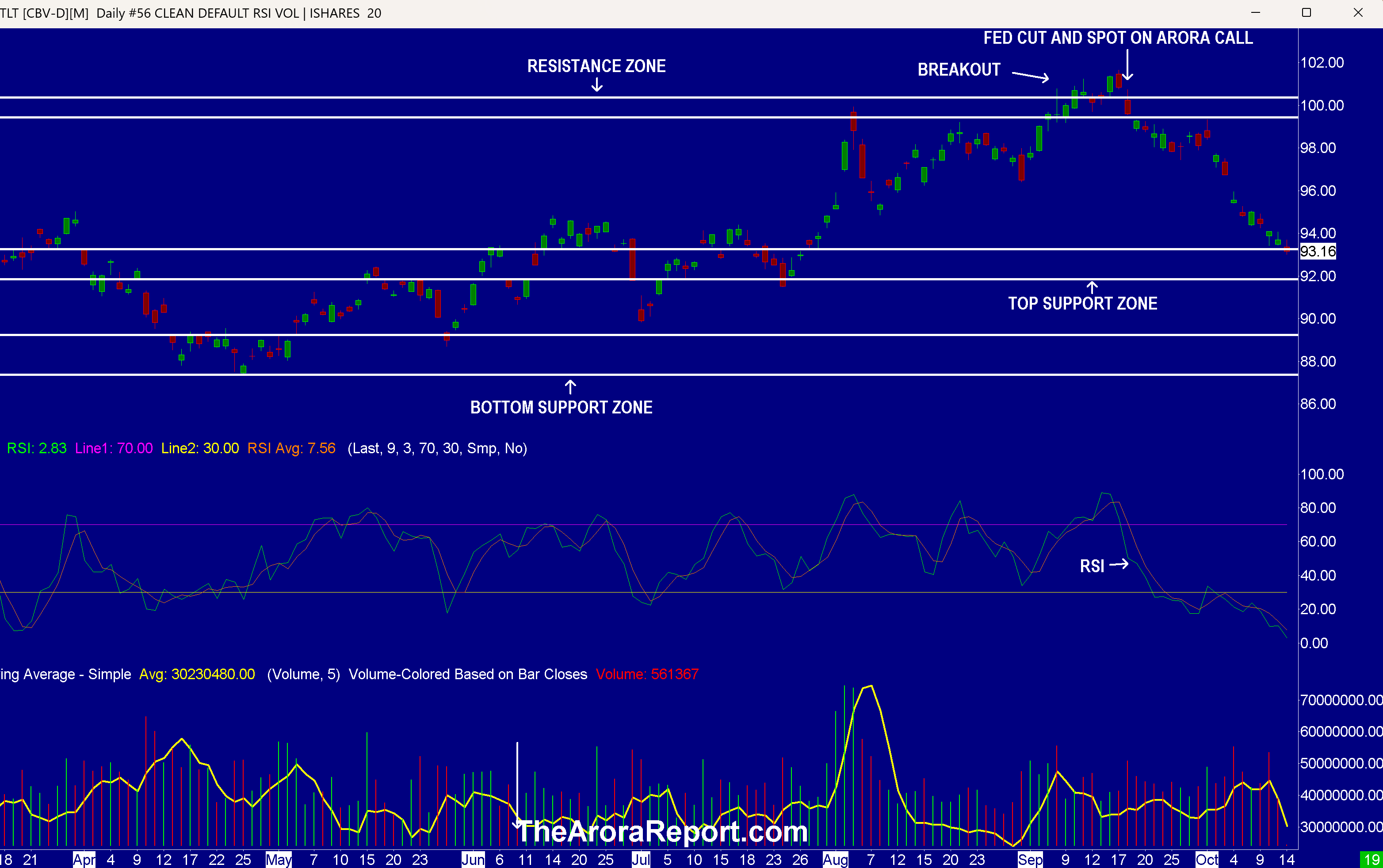
Bonds Defy Expectations
Please click here for an enlarged chart of 20+ year Treasury bond ETF TLT.
Note the following:
- Long bonds are defying expectations in the market.
- The chart shows when the Fed cut interest rates by 50 bps. At that time, TLT had shown a technical breakout. The expectations were for TLT to go higher.
- The chart shows the contrary Arora call that TLT would likely go down.
- We recently wrote:
In The Arora Report analysis, if it was not for the Middle East conflict escalation, TLT would have already fallen into the top support zone.
- The chart shows that The Arora Report call has been spot on. TLT has now hit the top band of the support zone.
- What happens next to long bonds will come down to the election. The prevailing consensus is that there will be a divided government. A divided government will be good for both stock and bond markets. If one party sweeps, there will be a high probability of TLT hitting the lower support zone.
- Bonds offer competition to stocks. Rising yields also lower PEs. For the time being, the stock market is drunk on the momentum generated by the 50 bps cut instead of a 25 bps cut. When the momentum wanes, the stock market will start paying attention to rising yields.
- Prudent investors should note that so far the data has not been supportive of the Fed’s decision to cut interest rates by 50 bps.
- Earnings season is in full swing. Earnings season will be a tell for AI. Undoubtedly, almost every company will hype AI. In the prior quarters, the stock of almost every company that mentioned AI ran up. Here is the key question: Will the stocks run again just on the mention of AI or will the market look for hard data regarding AI?
- After the weekend pump, the momo crowd buying in stocks in the early trade is aggressive.
- Traders are fixated on S&P 6000 as the magnet.
China
In a Saturday briefing, China did not offer new economic stimulus China also did not provide specific numbers as most investors had expected.
- Foreign investors are disappointed and selling Chinese stocks.
- Local investors are satisfied and buying Chinese stocks.
Magnificent Seven Money Flows
In the early trade, money flows are positive in Apple Inc AAPL, Amazon.com, Inc. AMZN, Alphabet Inc Class C GOOG, Meta Platforms Inc META, Microsoft Corp MSFT, NVIDIA Corp NVDA, and Tesla Inc TSLA.
In the early trade, money flows are positive in SPDR S&P 500 ETF Trust SPY and Invesco QQQ Trust Series 1 QQQ.
Momo Crowd And Smart Money In Stocks
Investors can gain an edge by knowing money flows in SPY and QQQ. Investors can get a bigger edge by knowing when smart money is buying stocks, gold, and oil. The most popular ETF for gold is SPDR Gold Trust GLD. The most popular ETF for silver is iShares Silver Trust SLV. The most popular ETF for oil is United States Oil ETF USO.
Bitcoin
Bitcoin BTC/USD is seeing buying for two reasons:
- Trump has moved up in the polls. Trump is considered more bitcoin friendly.
- Foreign speculators who are selling Chinese stocks are putting the money in bitcoin.
Protection Band And What To Do Now
It is important for investors to look ahead and not in the rearview mirror.
Consider continuing to hold good, very long term, existing positions. Based on individual risk preference, consider a protection band consisting of cash or Treasury bills or short-term tactical trades as well as short to medium term hedges and short term hedges. This is a good way to protect yourself and participate in the upside at the same time.
You can determine your protection bands by adding cash to hedges. The high band of the protection is appropriate for those who are older or conservative. The low band of the protection is appropriate for those who are younger or aggressive. If you do not hedge, the total cash level should be more than stated above but significantly less than cash plus hedges.
A protection band of 0% would be very bullish and would indicate full investment with 0% in cash. A protection band of 100% would be very bearish and would indicate a need for aggressive protection with cash and hedges or aggressive short selling.
It is worth reminding that you cannot take advantage of new upcoming opportunities if you are not holding enough cash. When adjusting hedge levels, consider adjusting partial stop quantities for stock positions (non ETF); consider using wider stops on remaining quantities and also allowing more room for high beta stocks. High beta stocks are the ones that move more than the market.
Traditional 60/40 Portfolio
Probability based risk reward adjusted for inflation does not favor long duration strategic bond allocation at this time.
Those who want to stick to traditional 60% allocation to stocks and 40% to bonds may consider focusing on only high quality bonds and bonds of five year duration or less. Those willing to bring sophistication to their investing may consider using bond ETFs as tactical positions and not strategic positions at this time.
The Arora Report is known for its accurate calls. The Arora Report correctly called the big artificial intelligence rally before anyone else, the new bull market of 2023, the bear market of 2022, new stock market highs right after the virus low in 2020, the virus drop in 2020, the DJIA rally to 30,000 when it was trading at 16,000, the start of a mega bull market in 2009, and the financial crash of 2008. Please click here to sign up for a free forever Generate Wealth Newsletter.
Market News and Data brought to you by Benzinga APIs
© 2024 Benzinga.com. Benzinga does not provide investment advice. All rights reserved.

